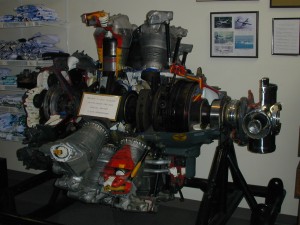 The Wright R-3350 Duplex-Cyclone was one of the most powerful radial aircraft engines produced in the United States. It was a twin-row, turbo/supercharged, air-cooled, radial engine with 18 cylinders. Power ranged from 2,200 to over 3,700 hp (1,640 to 2,760 kW), depending on the model. Developed before World War II, the R-3350’s design required a long time to mature before finally being used to power the Boeing B-29 Superfortress . After the war, the engine had matured sufficiently to become a major civilian airliner design, notably in its Turbo-Compound forms. The engine is now commonly used on Hawker Sea Fury and Grumman F8F Bearcat Unlimited Class Racers at the Reno Air Races.
The Wright R-3350 Duplex-Cyclone was one of the most powerful radial aircraft engines produced in the United States. It was a twin-row, turbo/supercharged, air-cooled, radial engine with 18 cylinders. Power ranged from 2,200 to over 3,700 hp (1,640 to 2,760 kW), depending on the model. Developed before World War II, the R-3350’s design required a long time to mature before finally being used to power the Boeing B-29 Superfortress . After the war, the engine had matured sufficiently to become a major civilian airliner design, notably in its Turbo-Compound forms. The engine is now commonly used on Hawker Sea Fury and Grumman F8F Bearcat Unlimited Class Racers at the Reno Air Races.
In 1927, Wright Aeronautical introduced its famous “Cyclone” engine, which powered a number of designs in the 1930s. After merging with Curtiss to become Curtis-Wright in 1929, an effort was started to redesign the engine to the 1,000 hp (750 kW) class. The new Wright R-1820 Cyclone 9 first ran successfully in 1935, and would become one of the most used aircraft engines in the 1930s and World War II, powering all frontline models (the -C through -G) of the B-17 Flying Fortress, the most legendary Allied heavy bomber aircraft to serve in the war. Each powerplant was assisted by a General Electric designed turbocharger for maximum power output at high altitudes.
At about the same time Pratt & Whitney had started a development of their equally famous Wasp design into a larger and much more powerful twin-row design that would easily compete with this larger Cyclone. In 1935 Wright decided to follow P&W’s lead, and started to develop much larger engines based on the mechanics of the Cyclone. This resulted in two designs with a somewhat shorter stroke, a 14-cylinder design that would evolve into the Wright R-2600, and a much larger 18-cylinder design that became the R-3350. An even larger twin-row 22-cylinder version, the R-4090, was experimented with as a competitor to the P&W R-4360, but was not produced.
The first R-3350 was run in May 1937. Continued development was slow, both due to the complex nature of the engine, as well as the R-2600 receiving considerably more attention. The R-3350 did not fly until 1941 after the prototype Douglas XB-19 had been redesigned from the Allison V-3420 to the R-3350.
Things changed dramatically in 1940 with the introduction of a new contract by the US Army Air Corps to develop a long-range bomber capable of flying from the US to Germany with a 20,000 lb (9000 kg) bomb load. Although smaller than the Bomber D designs that led to the B-19, the new designs required roughly the same amount of power. When preliminary designs were returned in the summer of 1940, three of the four designs were based on the R-3350. Suddenly the engine was seen as the future of Army aviation. Serious efforts were made to get the design into production.
